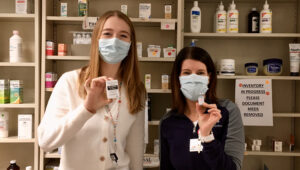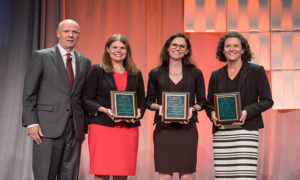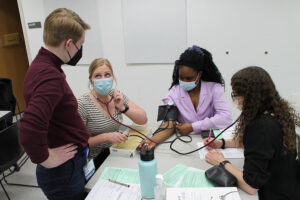Continuous education- and clinic-based research at the School of Pharmacy strengthens PharmD program and support student success
By Katie Ginder-Vogel & Katie Gerhards
The Doctor of Pharmacy curriculum at the University of Wisconsin–Madison School of Pharmacy is not a static list of objectives or accreditation requirements — it’s dynamic and continuously revised and optimized through faculty research.
“The School of Pharmacy is recognized nationally for what we do and the impact that we’ve made,” says Andrea Porter (PharmD ’06), associate professor in the School’s Pharmacy Practice Division and director of Pharmacotherapy Laboratories. “Some of our programs and initiatives are recognized as best practices across the country.”
Faculty from the School regularly perform education-based research and share their innovations with educators across the country through publications and presentations. Their work has resulted in numerous awards, including an Excellence in Assessment award from the American Association of Colleges of Pharmacy (AACP), a Lyman Award for best paper published in the American Journal of Pharmaceutical Education (AJPE), several AACP Scholarship of Teaching and Learning awards, and more.
But more important than awards, presentations, and publications, School of Pharmacy faculty use their research to continually improve and adapt the PharmD curriculum to keep the topics, applications, frameworks, and assessments cutting-edge.
“The School of Pharmacy is recognized nationally for what we do and the impact that we’ve made. Some of our programs and initiatives are recognized as best practices across the country.”
—Andrea Porter
“Because we consider every day how we teach and what we teach to be so critically important, because we believe so strongly in that if our students do it well here at the School, they will take what they’ve learned with them and impact patient lives down the line,” says Professor Beth Martin (BS ’90, MS ’03, PhD ’06), chair of the Pharmacy Practice Division and assistant dean for Teaching and Learning. “With the outcome in mind, we are always trying to do better.”
With a focus on course design, assessment, and clinical skills, faculty and staff take a holistic approach to educating student pharmacists, maintaining a focus on students’ future patients.
“I think the UW–Madison School of Pharmacy’s PharmD program is always ranked in the Top 10 nationally because we bring all these perspectives into the classroom every day,” says Martin.
Designing cutting-edge courses
At the School of Pharmacy, courses are designed with career outcomes in mind, which keeps the PharmD curriculum in sync with the profession’s changing needs and contributes to the School’s 96 percent placement rate within six months of graduation.
“We put a lot of thought into designing our courses and student interactions, getting stakeholder input, and applying the Absorb-Do-Connect framework,” says Martin. The Absorb-Do-Connect framework for course design focuses on giving students tangible ways to apply their classroom knowledge to connect it with real-life practice.
“We gravitate toward interactive courses and opportunities with our students, such as independent studies,” she says.

External stakeholder feedback has shaped numerous courses at the School of Pharmacy. Porter, Assistant Professor Ed Portillo (PharmD ’14), Associate Professor Casey Gallimore (PharmD ’05, MS ’13), and Associate Professor Susie Barnett (PharmD ’04), all of the Pharmacy Practice Division, published a paper in AJPE about the usefulness of incorporating external stakeholders’ feedback into the curriculum review process.
“We want to make sure that we’re preparing students to meet the wants and needs of health care systems in pharmacy practice, so we’ve done a lot of engagement with stakeholders within the School of Pharmacy as well as outside of the School of Pharmacy, talking to pharmacists in different practice settings,” says Gallimore.
Faculty and staff sought the perspective of employers and practicing pharmacists to develop specialized opportunities in the PharmD program, including the Rural Health Named Option, Applied Drug Development and Antimicrobial Stewardship Paths of Distinction, and the Residency-Track APPE (Advanced Pharmacy Practice Experience), which positions student pharmacists to thrive in postgraduate residencies.
“We built our Rural Health curriculum by doing evaluations with pharmacy alumni who are in rural practice settings to learn what they need and what skills make them successful in rural health, and then we applied that to the classroom and evaluated our students on how their learning changed in the class,” says Portillo.
The School’s Integrated Pharmacotherapy Skills lab series used a similar approach in its design, earning Gallimore, Porter, the lab series’ director, and Barnett the 2017 Rufus A. Lyman award from AACP. The team used a combination of focus groups, surveys, and course evaluations to redesign sequential skills-based courses to better prepare PharmD students for their fourth-year APPEs, or clinical rotations.

The Pharmacist Communication course with lab, coordinated by Social and Administrative Sciences Professor Betty Chewning, also brings in the expertise of practicing pharmacists, as well as standardized patients, to give feedback on students’ patient consultation skills.
Ensuring a leading curriculum also means looking toward the future of pharmacy and testing new learning opportunities. With the support of Scholarship of Teaching and Learning (SOTL) grant awards from AACP, which are designed to support research that generates new knowledge to advance pharmacy education, Porter and Gallimore each held pilot programs in 2019 to explore different aspects of pharmacy education.
Porter held a telepharmacy simulation, connecting School of Pharmacy PharmD students with student pharmacists in North Dakota, to help students build confidence in supporting a pharmacy technician and delivering patient education remotely, and published her results in Currents in Pharmacy Teaching and Learning. In collaboration with the UW–Madison School of Nursing, Gallimore held a transitions-of-care simulation to identify and prevent medication errors following hospital discharge, which will be an increasingly important skill as pharmacists are embedded more deeply into health care teams.
“A lot of our research has to do with keeping students at the forefront of pharmacy practice, how to be innovative in the classroom, and how that impacts student learning,” says Porter.
Rigorous assessment supports student outcomes
Assessment is another core area of faculty research at the School of Pharmacy, covering student self-assessment, observed skills, and preceptor (or clinical instructor) assessment. Thorough evaluation helps faculty improve the student experience, identify strong practices, and learn which processes or tools should be discontinued.
“Our group has consistently valued assessment,” says Martin. “We can know we hit the mark and why we hit it, which allows us to consistently pursue excellence.”
The faculty-developed Outcome Tracker tool won an Excellence in Assessment award from AACP in 2015, and in 2021 Health Services Research in Pharmacy graduate student Shweta Shah, Portillo, Gallimore, Porter, and Martin published a new scale to measure students’ ability to perform skills essential to the Pharmacists’ Patient Care Process.

“My education-based research is looking at what confidence and skills students are gaining in the classroom, and ensuring that they also transfer over to practice,” says Martin.
With School of Pharmacy Assistant Dean for Assessment and Academic Planning Beth Janetski, Martin and colleagues from other Big Ten pharmacy schools wrote a commentary about academic warning and intervention that advocates for integrating assessment professionals, pharmacy faculty, and student support services as a comprehensive way to capture academic, accountability, and behavior-related data to identify and support students who are struggling. A similar intervention is in place at the School.
Martin also helped create and implement a “course snapshot” tool to track changes, student performance, learning modalities, and evaluation methods for required courses in the curriculum.
“We are always looking at what we are currently doing, what data we have to analyze, and what improvements we can make,” says Porter.
Beyond Rennebohm Hall, during Introductory and Advanced Pharmacy Practice Experiences which puts students in clinical settings, pharmacy students are learning from preceptors, or clinical instructors. Assistant Professor Amanda Margolis (PharmD ’09, MS ’17) specializes her research in building preceptors’ skills and enhancing experiential education.
“We can know we hit the mark and why we hit it, which allows us to consistently pursue excellence.”
—Beth Martin
“Our preceptors are great at baseline, but we want to encourage them to be a little introspective on where they want to improve,” says Margolis.
In addition to developing preceptor resources, Margolis also led a project to assess preceptor’s use and perceptions of a validated tool, Individual Teamwork Observation and Feedback Tool (iTOFT), to help preceptors consistently observe and rate students’ interprofessional teamwork skills.
“iToft is an engrained interprofessional assessment tool that will always be a part of our curriculum,” says Margolis, who earned a 2021 New Investigator Award from the AACP to continue this work. “Interprofessional communication is a core aspect of what we do as pharmacists, and this gives our preceptors a framework and tools to help guide those conversations.”
Longitudinal experience with clinical skills
PharmD students at the UW–Madison School of Pharmacy get hands-on in the profession early. In their first year, students pharmacists are partnered with community-based older adults to develop early clinical skills and patient communication — a unique facet of the School’s curriculum that improves students’ skills and fosters their connection to the profession.
Elements of core clinical skills, including research, presentation of patient cases, and clinical inquiry are woven throughout every year of the PharmD program. And Margolis, Associate Professor Denise Walbrandt Pigarelli, and emeritus Professor Connie Kraus (BS ’75, PharmD ’93) published their research spotlighting the importance of longitudinally assessing pharmacy students’ skills with evidence-based medicine in AJPE.

“Instead of having a single course on evidence-based medicine, we realized that we really have to thread it through the curriculum and revisit it. Students need to tango with it a bit and keep scaffolding it and building it out,” says Martin.
Pharmacy Practice faculty regularly conduct practice-based research, too, and they bring that expertise and approach with them to the classroom.
“To teach students how to be practitioners, it is important to have a clinical practice and be involved in patient care,” says Porter. “And by doing so, we can bring best practices back into the classroom.”
Student pharmacists also have the opportunity to participate in clinical research with faculty mentors through independent study courses or the School’s Path of Distinction in Research.
“Many of us bring PharmD students into our research projects,” says Porter. ” As part of their pharmacy education, students are learning about the research process and best practices and getting involved with presentations, posters, and publications.”
“Tying clinical practice into teaching is a strength of our program because we do it so readily,” says Martin.
A holistic approach for well-rounded practitioners
The pharmacy profession is dynamic, multi-faceted, and collaborative. Pharmacy education at the UW–Madison School of Pharmacy reflects that.
As the Accreditation Council on Pharmacy Education (ACPE) codified the requirement for interprofessional education in all pharmacy schools, the School of Pharmacy was ahead of the curve in designing and implementing a systematic, progressive approach. Barnett, who is co-director of interprofessional education at the School, and Gallimore helped evaluate the impact of the new accreditation requirement and contributed interprofessional case studies for an illustrated comic-book-style guide for students.

To prepare student pharmacists to serve diverse patient populations, reduce health disparities, and encourage diversity within the profession, the School of Pharmacy faculty and staff integrated DEI (diversity, equity, and inclusion) content in the PharmD curriculum, and Portillo and colleagues published a paper about integrating cultural sensitivity training.
Faculty also research and publish ways to improve student support, including providing reasonable accommodations to students with learning disabilities in experiential education, coordinating accommodations between the skills laboratory and experiential learning environments, and addressing curricular and learning climate factors to maximize student engagement in meaningful experiences, optimize social connectedness, and provide individual student support.
Through this breadth of research covering education, assessment, clinical skills, and student success and well-being, the School of Pharmacy aims to prepare student pharmacists to not just participate in health care, but to advance the profession and transform patient care.
“If our students thrive here at the School of Pharmacy, they will thrive in practice,” says Martin. “If they thrive in practice, their patients will, too. That’s why we do what we do.”